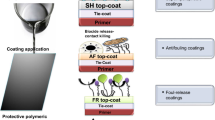Abstract
A mathematical model for a self-polishing antifouling paint exposed to seawater was extended to handle dynamic simulations. The aim has been to investigate, quantitatively, the transient responses of the paint to changes in seawater temperature, pH, concentration of NaCl, and ship speed. The simulation study revealed that polishing and biocide release rates for a paint present on a ship bottom rarely reach stable conditions, because of the slow response of the paint to changes in temperature and ship speed. It was also found that the paint behavior stabilizes more rapidly from a temperature or speed increase than from temperature or speed reductions. These results are essential for the testing of paints on ships and useful information in the development of novel self-polishing antifouling paints.
The modeling approach underlying the simulations can be applied to any type of self-polishing antifouling paint provided that sufficient kinetic, solubility, and diffusivity data are available for the pertinent rate steps influencing the paint behavior.
Similar content being viewed by others
References
Iselin, C.O.D. (Ed.),Marine Fouling and Its Prevention, Woods Hole Oceanographic Institution, U.S. Naval Institute, Annapolis, MD, 1952.
Samui, A.B., Hande, V.R., and Deb, P.C., “Synthesis and Characterization of Copoly(MMA-MA)-Cu Complex and Study on its Leaching Behavior,”Journal of Coatings Technology, 69, No. 867, 67 (1997).
Swain, G.W., “Biofouling Control: A Critical Component of Drag Reduction.” International Symposium on Seawater Drag Reduction, The Naval Undersea Warfare Center, Newport, RI, July 22–24, 155 (1998).
Warnez, M. and Hansen, O., “Self-Polishing Polymers for Antifouling Paints,” Federation of Scandinavian Paint and Varnish Technologists, 10th Congress, October 11–13, Copenhagen, 7.1 (1982).
Kuo, P. and Chuang, T., “Surface-Fragmenting, Self-Polishing, Tin-Free Antifouling Coatings,”Journal of Coatings Technology,71, No. 893, 77 (1999).
Gerigk, U., Schneider, U., and Stewen, U., “The Present Status of TBT Copolymer Antifouling Paints Versus TBT-Free Technology,”Prepr. Ext. Abstr., ACS Natl. Meet. 38, No. 1, 91 (1998).
Champ, M.A. and Seligman, P.F.,Organotin: Environmental Fate and Effects, Chapman & Hall, London, 1996.
Ryle, M., “Are TBT Alternatives As Good?”The Motor Ship, January, 34 (1999).
Kiil, S., Weinell, C.E., Pedersen, M.S., and Dam-Johansen, K., “Analysis of Self-Polishing Antifouling Paints Using Rotary Experiments and Mathematical Modelling,”Ind. Eng. Chem. Res., 40, No. 18, 3906 (2001).
Bowmer, C.T. and Ferrari, G., “A New Approach to the Development and Testing of Antifouling Paints,”J. Oil & Colour Chemists’ Assoc., 72, No. 10, 391 (1989).
Marson, F., “Antifouling Paints. I. Theoretical Approach to Leaching of Soluble Pigments from Insoluble Paint Vehicles,”J. Appl. Chem., 19, No. 4, 93 (1969).
de la Court, F.H. and De Vries, H.J., “Leaching Mechanism of Cuprous Oxide from Antifouling Paints,”J. Oil & Colour Chemists’ Assoc., 56, No. 8, 388 (1973).
Marson, F., “Antifouling Paints. II. More Detailed Examination of the Effect of Pigment Volume Concentration,”J. Appl. Chem. Biotechnol., 24, No. 9, 515 (1974).
Monaghan, C.P., Kulkarni, V.H., and Good, M.L., “Further Evaluation of a Diffusion Model for the Characterization of the Leaching Properties of Several Conventional Antifouling Coatings,” Report. TR-7. Gov. Rep. Announce. Index (U.S.), 78, No. 21, 171 (1978).
Kruglitskii, N.N., Avilov, V.O., Batyuk, V.P., and Shkurovich, M.Y., “Mathematical Modeling of the Leaching of Biologically Active Substances from Anticorrosive ‘Antifouling’ Coatings,”Dopov. Akad. Nauk Ukr. RSR (in Russian), 1, 30 (1983).
Caprari, J.J., Meda, J.F., Damia, M.P., and Slutzky, O., “A Mathematical Model for Leaching in Insoluble Matrix Films,”Ind. Eng. Chem. Res., 29, 2129 (1990).
Kiil, S., Weinell, C.E., Pedersen, M.S., and Dam-Johansen, K., “Mathematical Modelling of a Self-Polishing Antifouling Paint Exposed to Seawater—A Parameter Study,”Chem. Eng. Res. Des., 80 (A1), 45 (2002).
Levenspiel, O.,Chemical Reaction Engineering, John Wiley & Sons, New York, 1972.
Grasshoff, K.,Methods of Seawater Analysis, Verlag Chemie, Germany, 1976.
Patton, T.C.,Paint Flow and Pigment Dispersion, 2nd ed., John Wiley & Sons, New York, 1979.
Capurro, L.R.A.,Oceanography for Practicing Engineers, Griffith, D.E. (Ed)., Barnes & Noble Inc., New York, 1970.
Anderson, C.D., “Tin vs. Tin-free Antifoulings,”Conf. Proc., Protecting the Ship While Safeguarding the Environment, London, April 5–6, 1995. Society of Wetland Scientists, Kansas, 1.
Ferry, J.D. and Carritt, D.E., “Action of Antifouling Paints: Solubility and Rate of Solution of Cuprous Oxide in Sea Water,”Ind. Eng. Chem., 38, No. 6, 612 (1946).
Author information
Authors and Affiliations
Corresponding author
Additional information
Dept. of Chemical Engineering, Building 229, DK-2800 Kgs. Lyngby, Denmark.
Lundtoftevej 150, DK-2800 Kgs. Lyngby, Denmark.
P.O. Box 808213 Polinyà, Spain.
Rights and permissions
About this article
Cite this article
Kiil, S., Dam-Johansen, K., Weinell, C.E. et al. Dynamic simulations of a self-polishing antifouling paint exposed to seawater. Journal of Coatings Technology 74, 45–54 (2002). https://doi.org/10.1007/BF02698368
Issue Date:
DOI: https://doi.org/10.1007/BF02698368




